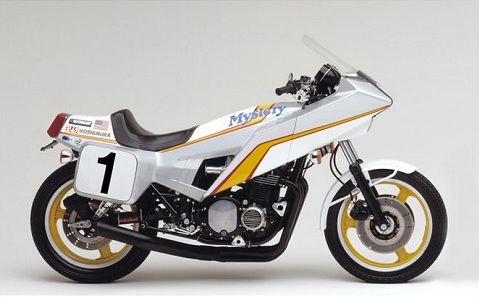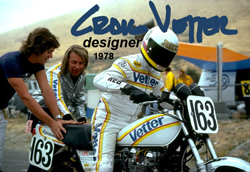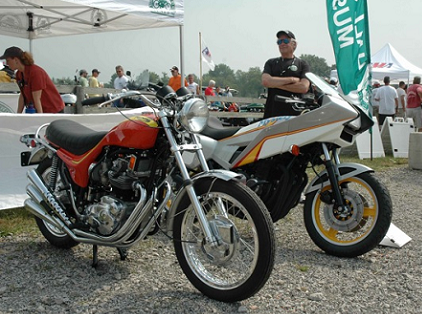Vetter Mystery Ship based on the Kawasaki KZ1000 Mk II

(Photograph by Frank Bez. Courtesy of Craig Vetter)
Click here to visit VetterMysteryShip.com
Just like the standard motorcycles in Kawasaki’s Z1 range, the 1980 Vetter Mystery Ship is a motorcycle that still looks stunning today…
…but this time, the credit for the styling goes to Craig Vetter.
Mystery Ship #1 shown in the photograph above has been donated by Craig Vetter to the American Motorcyclists Association Hall of Fame Museum in Ohio.
The Mystery Ship was based on the 1980 Kawasaki KZ1000 MKII. They cost $9,995 in 1980 when a stock KZ1000 MKII cost around $3,500.
Standard KZ1000 MKII frames were used, however, they had several modifications.
They were taken to Kosman’s where a frame jig was used to ensure accuracy, as the geometry of the Mystery Ship frames was to be the same as the Kawasaki KZ1000 racing motorcycle sponsored by the Vetter Corporation in the 1978 AMA Superbike Series.
(further information in the Brief History below)
The steering headstock was removed completely. It was replaced at 26° by a machined headstock fitted with 62mm tapered bearings.
The frames were strengthened, and all brackets that were not needed were removed. Rearset footpegs and a gear change linkage system were fitted. A shortened rear brake lever was used.
The mounting points for the Mulholland Force 1 rear shock absorbers were relocated further down the frame.
A box section swing arm was fitted.
3 spoke magnesium Dymag wheels were fitted with Michelin tyres, M45 front and M48 rear.
Standard Kawasaki brake discs and calipers were used with Ferodo pads.
A four into one Yoshimura exhaust system was fitted.
The bodywork was a two piece unit that covered a 6 US gallon fuel tank.
A Lockhart oil cooler was fitted into the nose of the fairing just below the headlight.
The Vetter Mystery Ship came supplied with a standard KZ1000 MKII engine which, according to Yoshimura, produced around 75 BHP at 9,000rpm, however, for those with a deeper wallet, several Yoshimura tuning options were offered.
Stage I. $799. 1105cc with 10,000rpm cam. (101 HP)
Stage II. $1134. As above but with 10,500rpm cam with ported and polished head. (108 HP)
Stage III. $1348. As Stage II but with larger valves. (116 HP)
Stage IV. Superbike specification. Prices were available on application.
For those wanting a Turbo Charged option, for around $1,700, Vetter would work with Russ Collins of R.C. Engineering.


The original plan was for 200 Mystery Ships to be built. However, Craig Vetter had a hang glider crash which forced him to stop production after only 10 Mystery Ships had been built, so a Mystery Ship is a rare motorcycle.
Whilst recovering from his accident, Craig began to reflect on what he felt was more important. Although the Mystery Ship had been an important development, he decided to turn his efforts to bringing attention to fuel economy with the development of his Streamliner, a subject he has remained passionate about to this day.
“What does it really take to push a person down the road at 55mph?
...Craig Vetter
A Brief History of Craig Vetter and The Vetter Corporation.
Craig Vetter was born in 1942 in Alabama. He moved with his family to Illinois when his father retired from the US Air Force.
After riding motorcycles on long journeys, Craig realised that it would be much more pleasant to ride if there was some protection from the wind and weather. He also knew that fuel economy would be improved if wind resistance could be reduced.
Craig became fascinated by motorcycle fairing design, and started to experiment with various designs.
He went on to form The Vetter Corporation and sold his first range of fairings in 1966.
Craig has always had a passion for British motorcycles. In 1969, he created a design that was originally based on the BSA Rocket 3 motorcycle. However, the design eventually became known as the X-75 Triumph Hurricane.
Vetter is perhaps best known for Windjammer Fairings that were introduced in 1971. Luggage Systems to match the Windjammer Fairings were introduced in mid 1978.
In the mid 1970s, Craig Vetter rode Rickman framed Kawasakis in several races. He was not just after race wins. The purpose was to develop his own ideas for a racing motorcycle.
1976 was the first year of the AMA Superbike Series. The Series was won by Reggie Pridmore riding a BMW R90S.
In 1977, Reggie won the Series again, this time riding a Racecrafters Kawasaki KZ1000 tuned by Pierre des Roches.
In 1978, the Vetter Corporation sponsored Reggie to ride in the AMA Superbike Series.

The Team Vetter motorcycle was also a Kawasaki KZ1000 tuned by Pierre des Roches.
Reggie won the Series for the third time in a row.
The 1978 Team Vetter KZ1000 Superbike, along with Craig’s earlier experience on the Rickman Kawasakis, led to the design of the Mystery Ship.
In November 1978, Craig Vetter sold the Vetter Corporation and moved to Carmel, California with his wife Carol and two sons, Zak and Morgan.
Craig Vetter was inducted into The AMA Motorcycle Hall of Fame in 1999.

Craig still remains active in the motorcycle world and is involved in many projects involving improvements in motorcycle fuel economy.
Visit www.craigvetter.com for more information.
I would like to thank Craig Vetter for his permission to use the photographs on this page and for providing me with information about the Vetter Mystery Ship.